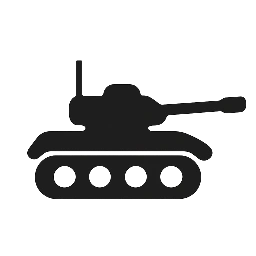The T-55 is one of the most produced and widely exported tanks in history, developed by the Soviet Union as an evolution of the earlier T-54. Introduced in the late 1950s, it saw extensive service globally and became a mainstay of many armies during the Cold War era. The T-55/56 designation generally refers to the T-55 and its immediate upgrades or licensed versions used by Warsaw Pact and non-aligned nations.
General Specifications:
- Country of Origin: Soviet Union
- Type: Main battle tank (MBT)
- Service Entry: 1958
- Crew: 4 (commander, gunner, loader, driver)
Dimensions:
- Length: 9.00 metres (29 ft 6 in) with gun forward
- Width: 3.27 metres (10 ft 9 in)
- Height: 2.40 metres (7 ft 10 in)
- Weight: 36 tonnes (T-55A variant)
Powerplant and Mobility:
- Engine: V-55 12-cylinder diesel engine
- Horsepower: 580 hp (432 kW)
- Maximum Speed: 50 km/h (31 mph) on road, 27 km/h (17 mph) off-road
- Range: 500 km (310 miles) on road (with auxiliary fuel tanks)
- Suspension: Torsion bar suspension
Armament:
- Main Armament:
- 100 mm D-10T2S rifled gun (the same gun from the T-54 series)
- Ammunition Capacity: 43 rounds (APFSDS, HEAT, HE, and ATGM rounds in later versions)
- Secondary Armament:
- 1 x 7.62 mm SGMT coaxial machine gun
- 1 x 12.7 mm DShK anti-aircraft heavy machine gun (on later variants like the T-55A)
- 1 x 7.62 mm SGMT bow-mounted machine gun (optional)
Armour:
- Hull Armour:
- Frontal: 100 mm
- Side and Rear: 80 mm
- Turret Armour:
- Frontal: 200 mm
- Side and Rear: 150 mm
- The T-55’s armour was an improvement over the T-54, particularly in its turret, which retained the signature rounded shape that offered good ballistic protection.
Design Features:
- Nuclear, Biological, and Chemical (NBC) Protection: The T-55 was the first Soviet tank to incorporate full NBC protection, allowing the crew to operate in contaminated environments. This feature was a significant advancement, reflecting the Cold War context.
- Improved Fire Control: While early models lacked sophisticated night vision, later variants were fitted with infrared searchlights and passive night vision systems, enhancing their combat effectiveness at night.
- Ammunition Types: The 100 mm D-10T2S gun was capable of firing a wide range of ammunition types, including APFSDS (Armour-Piercing Fin-Stabilised Discarding Sabot) for anti-armour, HEAT (High-Explosive Anti-Tank), and HE (High Explosive) rounds. The gun also became capable of launching anti-tank guided missiles (ATGMs) in later variants, improving its ability to engage targets at longer ranges.
Operational History:
The T-55 entered service in 1958, quickly replacing earlier models like the T-54 as the mainstay of Soviet and Warsaw Pact forces. Its design improved upon the T-54 in several key areas, such as better NBC protection, more reliable components, and improved ease of production.
The T-55 was exported to numerous countries across Africa, the Middle East, Asia, and Eastern Europe. It saw combat in virtually every major conflict during the Cold War and after, including:
- The Arab-Israeli Wars (1967, 1973)
- The Vietnam War
- The Iran-Iraq War (1980–1988)
- The Gulf War (1991)
- The Yugoslav Wars (1990s)
- Numerous post-colonial and civil conflicts in Africa and the Middle East
Upgrades and Variants:
- T-55A: Introduced in 1963, this variant featured enhanced radiation protection and added the 12.7 mm DShK anti-aircraft machine gun on the turret.
- T-55AM: A modernised version with improved fire control systems, stabilisers for the main gun, and the capability to launch ATGMs (such as the 9M117 Bastion missile).
- T-55M: Another modernisation package with ERA (Explosive Reactive Armour), laser rangefinders, and more advanced targeting systems.
- T-55M6: A further upgrade that incorporated many aspects of the T-72, such as a new engine, better armour, and an autoloader.
License-built versions and foreign variants:
- Type 59: China’s license-produced version of the T-54/T-55, which evolved into various models with improved firepower and technology.
- Romanian TR-580/800: Local variants of the T-55 produced in Romania, often featuring more modern fire control and armour.
- Tiran: Israeli-modified T-55s captured during the Arab-Israeli Wars, upgraded with Western technology, including better guns and electronics.
Legacy:
The T-55’s combination of simplicity, durability, and ease of maintenance made it highly popular with nations that needed reliable tanks in large numbers. It became a symbol of Soviet armoured warfare, often used by developing nations as the backbone of their armoured forces well into the 21st century. Even today, upgraded versions of the T-55 continue to serve in various militaries, having been retrofitted with modern equipment to remain competitive on the battlefield.

Leave a Reply